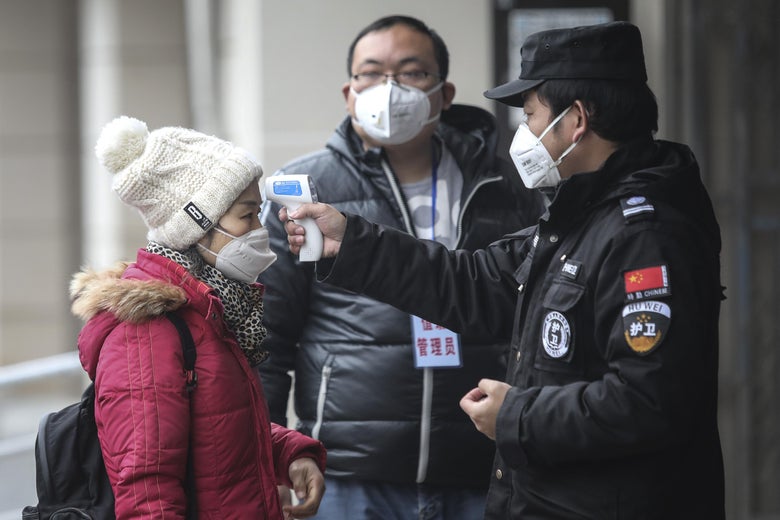
Security personnel check the temperature of passengers in the Wharf at the Yangtze River on Jan. 22 in Wuhan, China.
Stringer/Getty Images
On Wednesday the Chinese government announced a partial quarantine of Wuhan, the city of 11 million at the center of a deadly coronavirus outbreak, with all major modes of public transit shut down. The severe measure was prompted by growing concern over the pneumonia-like virus that doesn’t respond to antibiotics. According an ongoing tally from the state-run Global Times, there are 548 cases of the new strain of coronavirus in China as a whole. The Hubei provincial government confirmed today that at least 17 people have died.
The lockdown on public transportation in Wuhan, a transport hub for central China, starts at 10 a.m. on Thursday. Officials have warned residents to stay put unless they have a “special reason” for travel.
The quarantine measures come just before Lunar New Year on Saturday, one of the country’s busiest travel weeks. Each year, around 3 billion domestic trips are made during the 40-day festival, which for some is the only time of year to see family. But the coronavirus is already disrupting travel plans. The Chinese government is concerned about the surge in travel while the outbreak continues, and a senior health official has advised people to refrain from traveling to Wuhan. These measures could have a significant economic impact on the country: in 2019, for instance, Chinese spent $74 billion on travel and $145 billion on shopping and food over the holiday period.
The World Health Organization has praised China’s steps to address the outbreak. “What they’re doing is a very, very strong measure,” Tedros Adhanom Ghebreyesus, the director-general of WHO, said in a press conference this afternoon. Some Chinese citizens, however, argue that the government’s delay in reporting information about the virus has been irresponsible, with similarities to the country’s belated response to the severe acute respiratory syndrome (SARS) pandemic—a similar, but more virulent, outbreak that resulted in over 700 deaths in 2002 and 2003.
The coronavirus, which is transmitted through the respiratory tract like SARS, has already spread to other cities in East Asia, with isolated cases around the globe. China’s Bureau of Disease Prevention and Control has declared the virus “highly infectious,” while WHO’s Emergency Committee decided today that it needs more information to determine whether the outbreak is a “Public Health Emergency of International Concern.” Meanwhile, the U.S. Centers for Disease Control and Prevention raised the travel notice for Wuhan from level 1 to level 2 on Tuesday, advising travelers to “practice enhanced precautions,” and the U.K. foreign office followed suit today but with more drastic precautions, advising against all but “essential travel” to the city.
Although CDC in Atlanta confirmed the first case of the new coronavirus in the U.S. on Tuesday, national concern has not yet heightened. The individual, who recently visited Wuhan and arrived in Seattle on January 15, is faring well and remains isolated for the time being at Providence Regional Medical Center in Everett, Washington. The U.S. has responded to the incident with plans to impose stricter screenings of plane passengers from Wuhan, who will only be able to arrive in the country at 1 of 5 planned airports
“We believe the risk to the public is low,” said John Wiesman, secretary of health for the state of Washington.
Readers like you make our work possible. Help us continue to provide the reporting, commentary and criticism you won’t find anywhere else.
Join Slate Plusfrom Slate Magazine https://ift.tt/2sLjX62
via IFTTT
沒有留言:
張貼留言